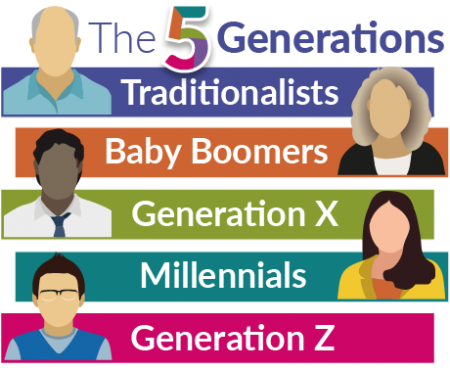5 Generations in the workplace
The age of no retirement?
We contemplate what changing retirement practices and having 5 generations in the workplace simultaneously, could mean for us all.
When we read the article entitled ‘Have we reached the age of no retirement?’, our first reaction was one of fear at the prospect of a working life without end.
Then we remembered that we enjoy what we do very much, and that continuing to do it for a good few years longer would be a very good thing indeed. But regardless of our personal hopes and fears for older age, as health and safety professionals we need to understand the significance of demographic changes for workplace health and safety, and organisational performance.
Why are people working into older age?
The government removed the default retirement age in 2011, and these days many people enjoy better health into older age. They are therefore working later in life to boost their retirement income, to maintain a better lifestyle, or to help children needing a foot-up onto the housing ladder.
The consequent reduction in retirees means the age range of those in work is broadening. The age at which people can enter the workplace (16 years old) is unchanged, and as many commentators are pointing out, there are now 5 generations in the workplace. These span so called Generation Z (born after 1996), through to Traditionalists (born 1945 or before).
The advantages of an age diverse workforce

In many ways, age diversity in the workforce is hugely advantageous. Each generation has distinct preferences, priorities and mindsets in relation to how they work. Older workers are considered dedicated, honest and experienced, while the youngest – Generation Z – are considered tech savvy and collaborative.
Download descriptions of the 5 generations
The death of traditional fixed working space
For the health and safety community, what’s important is to understand that different generations have different reactions to the death of the traditional fixed working space, and the rise of flexible working. And there is evidence to suggest these changes disproportionally affect the older worker.
Traditionalists with strong work ethics may struggle with the concept of working from home, in cafes or on trains. They may find communication more difficult with colleagues who aren’t routinely in the office. Meanwhile, Baby Boomers may feel disconnected from social media style communication channels which can be used anywhere at any time.
Technologies, working practices and workplace design
New technologies and working practices have led to changes in workplace design. Increased hot desking, more collaboration space and open plan offices carry ergonomics risks for older workers, who are used to a fixed workstation, set up to meet their individual ergonomic requirements.
Consider this
Enter the health and safety professional, charged with ensuring that with 5 generations in the workplace, our diverse range of workers remains healthy and safe. To succeed, you’ll need to consider ergonomic workplace design, strategies to educate the different generations in how to work safely, and the differing health issues that each generation may face.
Those charged with managing workplace safety, workspace design and workplace ergonomics have their work cut out to respond to the needs of a varied workforce.
It looks like we won’t be retiring anytime soon, then!

Discuss your challenges with expert consultants – Contact us
